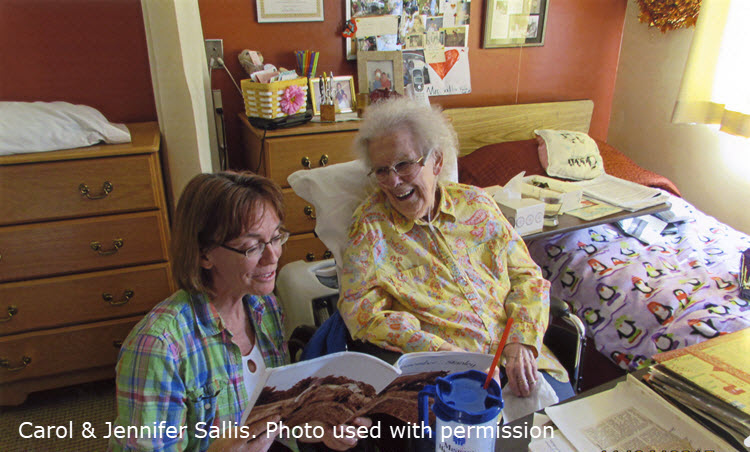How visits and technology keep you connected.
In last week’s blog, we learned how fostering connections in an assisted living facility opens the door to an extended family. Fostering connections helped Jennifer and her mother create family out of non-family, key to adjusting to assisted living or a nursing home. Continuing my conversation with Jennifer, I was struck by a life lesson from her dad who worked as a family doctor
Jennifer: “Dad once pointed out that the medical world often uses the term ‘disease’ because that is what is being treated, yet ‘illness’ is more what the patient experiences,” she recalled. “Not that aging is an illness, but it can bring on weakened physical states and changing mental capacity. Family, friends and care staff who are truly connected can provide care that is life-focused instead of diseased-focused. For me, Mom living in her familiar small hometown was a comfort and a blessing because she felt connected to cousins, neighbors, friends and her church.”
How can we as family, help our loved ones to adjust?
Start with knowing that seniors do well if their family participates in activities with them. In general experts recommend:
- Attend meals, special events and family days at the facility. Introduce yourself to tablemates and other family members. Get to know them and give them a chance to know you.
- Go with them to activities and participate for a time or two until they get acclimated.
- If your senior loves to sing, look for an in-house choral group they can join.
- Ask about activities lead by other residents, like bible studies.
Speaking from her personal experience, Jennifer has some terrific ideas.
What recommendations do you have for other families to keep connected?
“Do the things you always did until you can’t do them anymore.”
- If you had dinner every Sunday afternoon as a family, then continue that ritual, go have dinner at the facility.
- If Mom got her hair done every Saturday, then continue to pick her up and take her to the hairdresser.
- Keep up the rituals, the day to day things as much as possible. “Mom continued to attend the monthly breakfast meetings with her family. I took her when I was in town, and other family members would make sure she was included when I was not there. It kept the connections and she enjoyed this time.”
How did you keep mom included in your life and you in hers, when you were far apart?
- I spoke to my mother almost every night.
- I would talk about my job and travels, sometimes even practice a presentation for work!
- I knew the names of her friends. I would ask about them.
How did you spend time with your mom when you visited Wisconsin?
“I always looked for fun things to do with her.”
- We would play cards, look through photo albums.
- I would bring things with me to show her.
- I would sing with her or read her something she knew or loved all her life. It was very comforting.
- We spent time reminiscing, even driving past her grade school, and family homes, familiar places to start a discussion.
- Once I put on a fashion show for her and the other ladies that were mom’s friends.
- For one of her birthday’s I brought a reflexologist to her room and she had her “foot massage” as she called it.
- Getting together with long-time friends or cousins.
In what ways did technology keep you connected with you mom?
- “Mom was a master on the typewriter but didn’t take to computers, so I built Skyping into mom’s care plan. With staff help we could skype together from time to time. Once I was able to share a holiday concert live at the Princeton Cathedral via skype. Mom watched that beautiful music performance from 1,000 miles away. Another time I sang in a concert and set up my phone on a windowsill pointed towards the choir. She was thrilled, I was too. My husband was in the audience – and so was my mom!”
- “Mom’s end of life health changes prompted the move to a nursing home, where care staff were also helpful. Continuing to appreciate visits from local cousins, friends, and church members, I did find it harder to speak with Mom by phone – attention span and hearing difficulties – so staff would allow me to email a one-page large-font note which they’d print and bring to her. This gave Mom time to read through a few times and share with visitors.”
Even with all the technology advances, Jennifer believes that ‘showing up, being present’ was simply the best way to stay connected. A person’s desire to be truly connected with others, to be heard, to love and be loved – remains constant.
Disclaimer: The material in this blog is for educational purposes only. It is not intended to replace, nor does it replace, consulting with a physician, lawyer, accountant, financial planner or other qualified professional.

